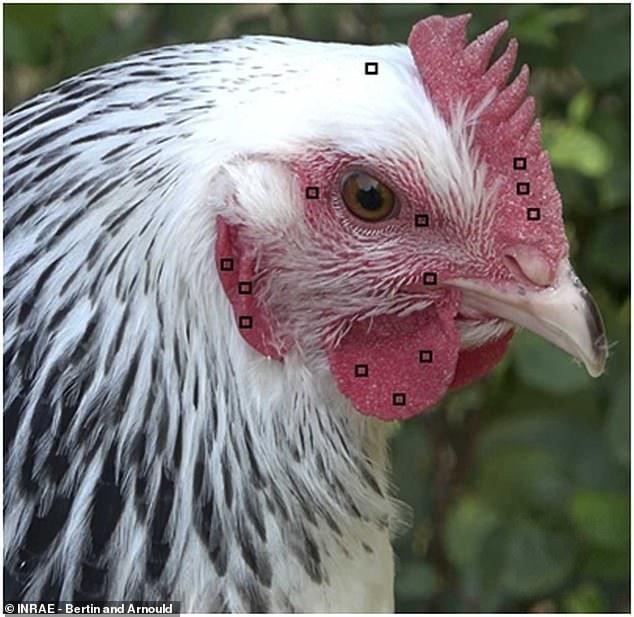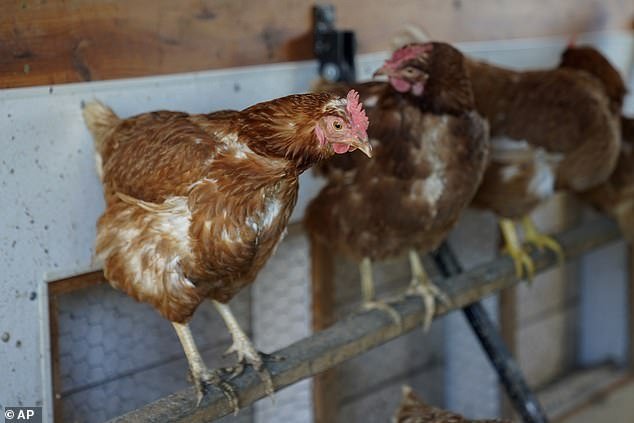Chickens get red in the face when they are nervous – just like humans, research shows
Turning red with anger may seem like a uniquely human trait.
But according to scientists in France, chickens also change during “negative situations of high arousal.”
In a new study, chickens were either given a delicious treat of mealworms or captured by one of the researchers while cameras captured their faces.
While the chickens turned a little red when they were happy, the scientists found that they turned the most color when they were nervous or irritated.
Chickens have many blood vessels close to the surface of the skin on their faces, so the skin turns bright red as blood flow increases.
Researchers have found that chickens that are angry or scared (right) are much redder in the face than chickens that are calm (left)
The study was led by researchers from the French National Research Institute for Agriculture, Food and the Environment (INRAE).
Delphine Soulet, one of the authors of the study at INRAE, told MailOnline: ‘This finding could, for example, help to evaluate the quality of the human-animal relationship.’
Reddening of the face during times of excitement has already been observed in a few other birds, such as the blue and yellow macaws.
To see if chickens showed a similar response, researchers from the French National Research Institute for Agriculture, Food and the Environment (INRAE) observed six Sussex laying hens over a three-week period.
The birds were given a delicious treat of mealworms or were captured by the researchers and held with their wings covered for a minute.
During this time, the chickens were carefully recorded, collecting 18,000 different photos of their faces.
Using a computer program designed by the researchers, they were able to observe that the chickens became much redder during periods of unrest.
Ms Soulet said: ‘In our research we found that chickens blush in positive situations of high arousal linked to reward and pleasure.
‘But the most intense blushing was observed in negative situations of high arousal, for example when catching the chickens.’

The chickens’ faces were studied by a computer program that assessed the details of their faces (pictured) to see how they became redder when shaken
It is not known exactly why chickens blush in this way, but Ms Soulet suggests it could have a ‘signaling function’ to show emotional states to other birds.
Meanwhile, a paler face is a sign of “calmness and contentment,” because chickens that were resting showed little redness until something upset them.
The researchers were also able to use this information to see how chickens became accustomed to humans over time.
A group of 13 chickens were slowly adapted to humans over time, while another 13 chickens were left alone.
The group that had been acclimated maintained a lighter skin color, indicating a calmer state when the experimenter was around.

These three photos show a chicken in different states. The chicken’s face is pale when calm (left), slightly redder when receiving a reward (middle) and much redder when captured (right)
The researchers say this could be a test of the strength of the relationship between humans and chickens, and could show when chickens feel more comfortable around people.
Ms Soulet added: ‘More broadly, these new facial markers of emotion could be used in other bird species kept in captivity for conservation programs or as pets.’
In their article, published in Applied Animal Behavioral Sciencesthe researchers write that understanding the emotional or ‘affective’ states of birds is the key to ‘understanding their feelings’.
However, assessing the extent to which animals such as chickens feel emotions is extremely difficult.

The researchers say the use of this technique could be used to assess the welfare of chickens in captivity and to assess the quality of human-chicken relationships (file photo)
Ms Soulet explains: ‘Defining emotional boundaries in humans is already a challenge on which there is no real consensus so far.
“Even determining whether two people share a similar emotional range is difficult and subject to cultural influence.”
It is believed that all vertebrates, including birds, have the same six basic emotions: fear, joy, anger, disgust, sadness and surprise.
Previous research has also suggested that chickens can feel a kind of empathy, especially in chickens whose chicks are disturbed.
Chickens also display a wide range of emotions in their clucking sounds, which can be easily distinguished by humans.
Still, Ms. Soulet says this doesn’t necessarily mean chickens feel emotions in the same way we do.
“We would rather say that they can feel fear or anger-like emotions, for example,” says Ms Soulet.
